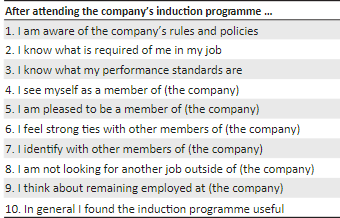Optimizing New Joiner Induction Program
There are numerous procedures involved when a new employee joins a company. However, a number of such actions are primarily in your organization's best interest. They certainly do not aid a worker in performing their duties more effectively, avoiding typical mistakes, boosting productivity, or feeling a part of the team.
Induction metaphors are inter-personally translated via interactive discourses of the induction process, building on the idea of "interaction imbalances" (Drew and Heritage, 1992). In this framework, the function of newcomers and trainers is demonstrated and investigated.Starting an employee induction program can take so much labor that it can bog down completely and never reach its initial version. Additionally, there will be important lessons learned from the initial iteration of your staff induction program. These lessons may alter how you see future iterations or additions to the program.
This article explores the discursive construction of new hire induction and how it may affect how organizational entry is framed in connection to change management strategies. The discursive aspects of the change management process have recently drawn more attention (Oswick et al., 2005; Marksak and Grant, 2008), and a special issue of the Journal of Applied and Behavioral Science was just published in 2010 to reflect on the main research agendas and suggest future directions.
Now let's
consider about how to improve employee induction training. What topics must be
covered, how can the training be organized effectively, and what are the most
important blunders to avoid for a positive employee on-boarding experience?
What we call an induction program
Induction program is basically what companies/ organizations present to their new joiners as a preparation. Specially to be well aware of the company and how the process is going on, what are their job responsibilities, what kind of facilities and benefits they are entitled as an employee of the company.
Normally, an induction program should include major training also, such as industrial safety, fire safety, counselling programs and awareness programs. Effective induction program should include TPI theory. The theory refers as, new employees must develop. Theoretical and practical skills towards the performance of the new carrier. But same time they have to have interaction that exist among the new joiners. When we consider the main benefits of having proper induction program can be listed as
- Company can pay their best attention to the health and safety of the new employees
- Increase the good knowledge management process of new employee
- Helps to reduce short term turnover of staff of the company.
2. Medical insurance briefing
The purpose of the employee insurance policy is to offer protection and benefits at work in accordance with the guidelines established by the government. The policy provides compensation to employees for potential life-threatening job dangers and risks. Such a policy is typically designed by companies like factories, which include strenuous physical labor, to support their employees. Rules and regulations regarding the employee insurance will be provided during the conduction.
Payroll, benefits, and other crucial HR topics should be covered in this module or session. holidays, sick days, locations of policies, performance assessments, HR contacts, etc. Since this module is often the same for every employee, it can be of the most benefit. You can save a ton of time by not having to redo this session manually for each new employee if you can develop this module online and follow it up with possibly a brief HR.This may assist in illustrating the usefulness of online induction modules.
4. Employee assistance program briefing
5. Management briefing
Start the paper by briefly outlining the organization's expectations for how employees should present themselves at work and why this is crucial to the operation of the company. Employees will get general recommendations in this area regarding suitable attire as well as other topics including tattoos, hygiene, and jewelry.
Ideal program activities for induction program : source : Hendricks, K., & Louw-potgieter
Conclusion
Induction program might take the form of formal training, informal induction provided by coworkers and supervisors, or a combination of the two. We need to keep in mind that the primary objective of induction is to lessen the fear or anxiety experienced by new employees considering settling into a job or performance. New recruits are particularly vulnerable in the initial few weeks of employment, and that a bad orientation materially increases the likelihood of attrition. Therefore, it's crucial for a company to have a system in place to take advantage of the first sense of optimism and leave its mark on how the company runs.
https://www.youtube.com/watch?v=KOdbZ1D1DZU
References
Lakoff and Johnson, 1980; Pinder and Bourgeois, 1982; Tsoukas, 1991; Marshak, 1993; Grant and Oswick, 1996; Palmer and Dunford, 1996; Gibson and Zellmer-Bruhn, 2001.
Drew, P., & Heritage, J. (1992). Analyzing Talk at Work: An Introduction. In P. Drew, & J. Heritage (Eds.), Talk at Work. Interaction in Institutional Settings (pp. 3-65). Cambridge: Cambridge University Press



Comments
Post a Comment